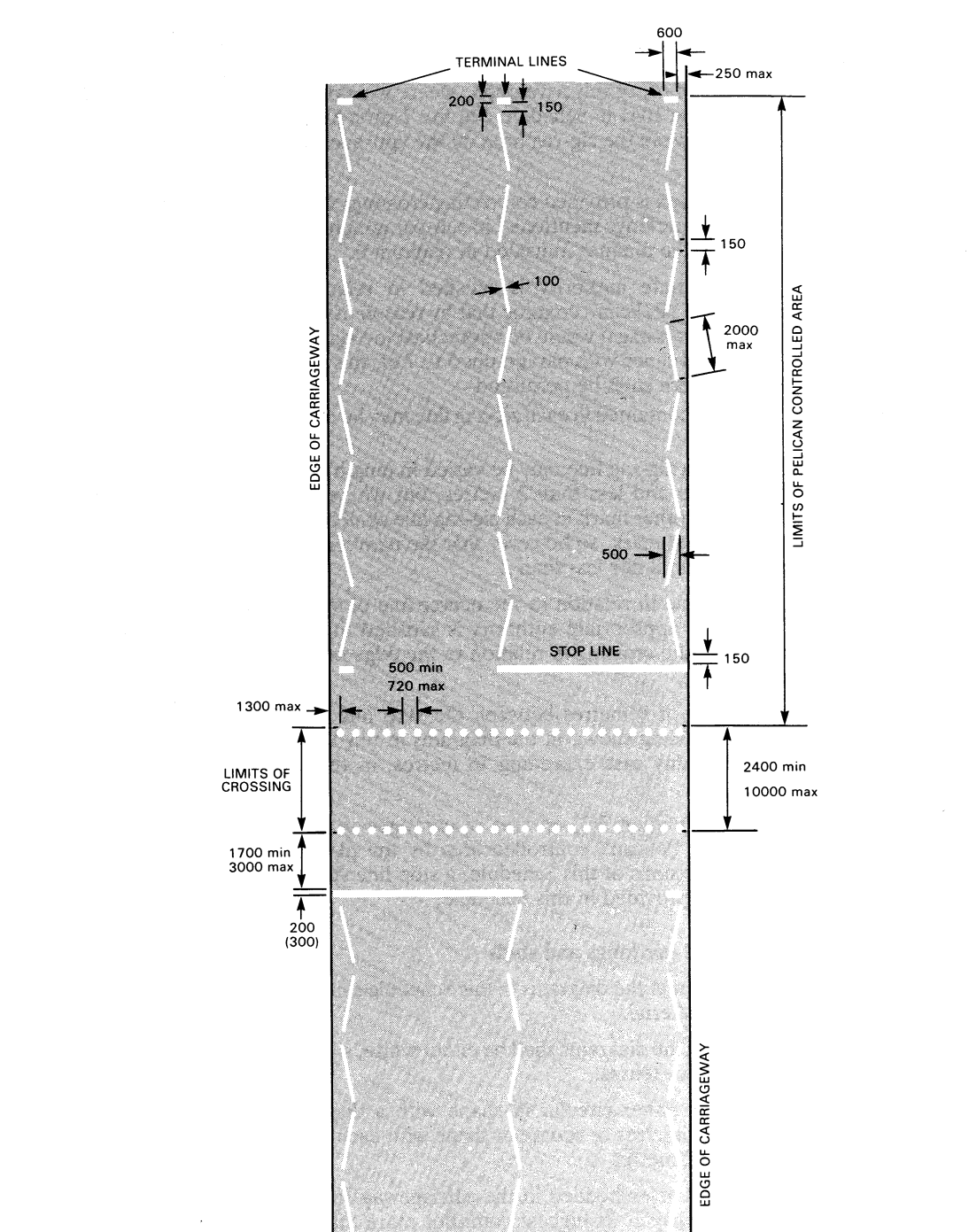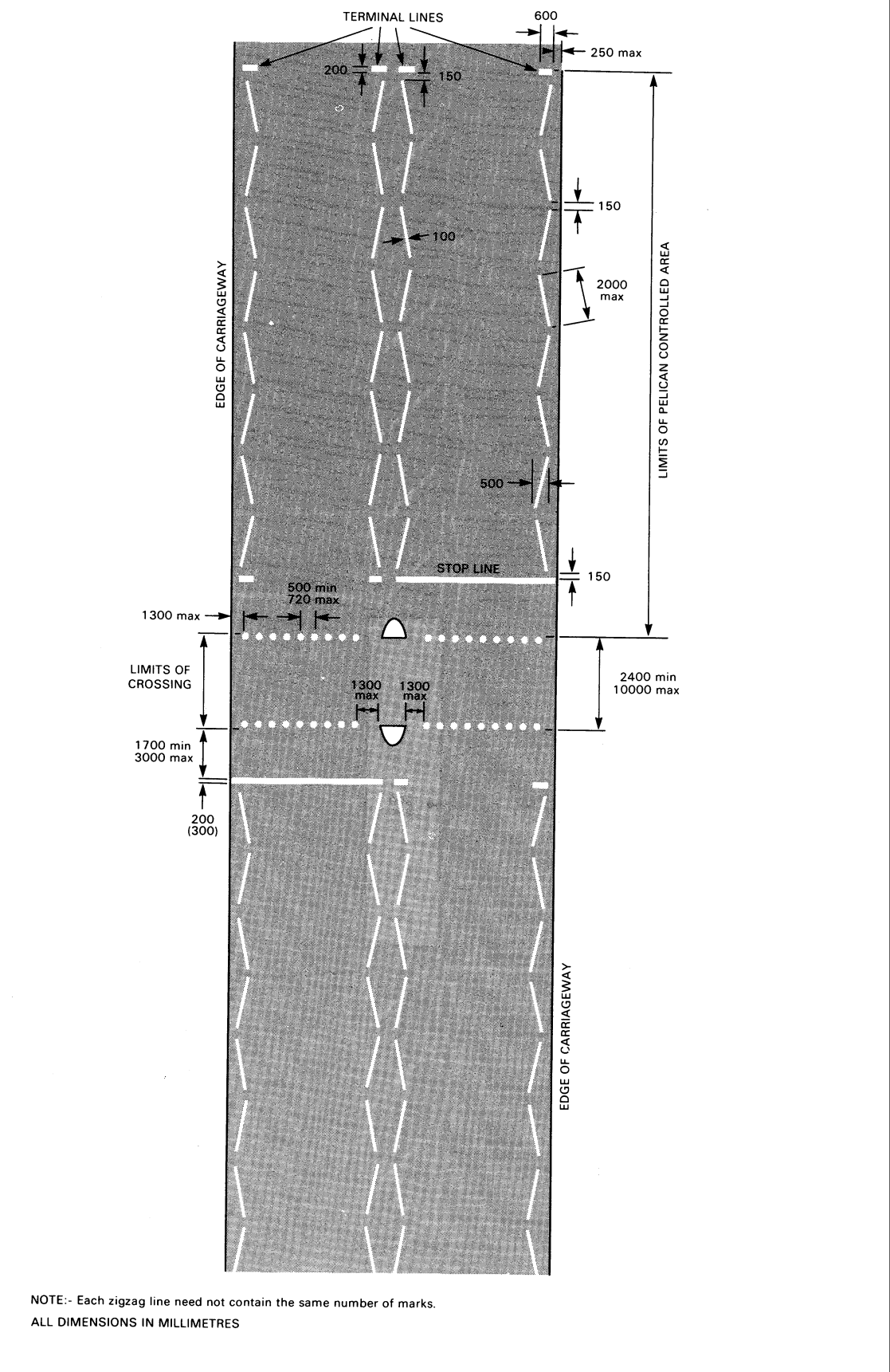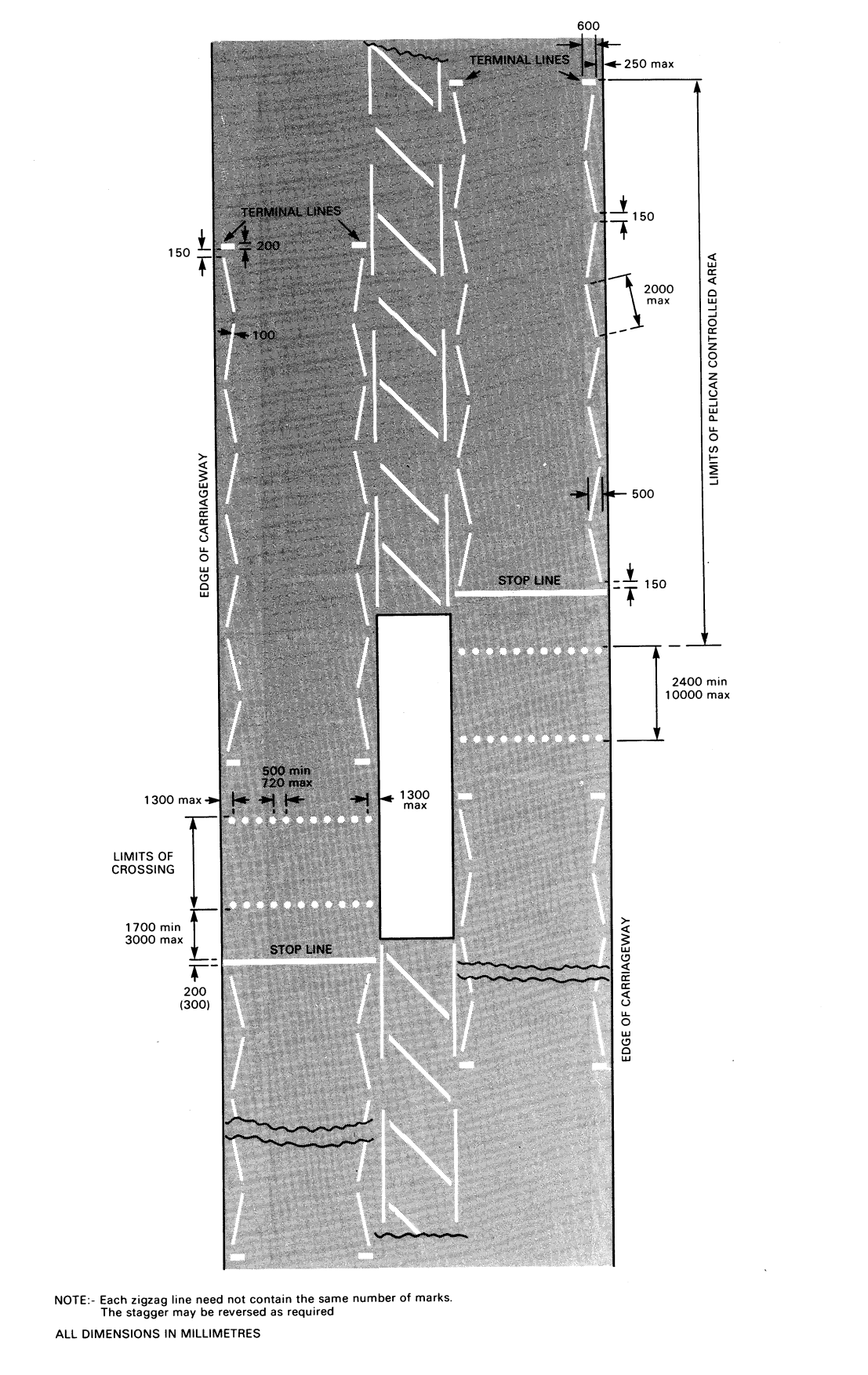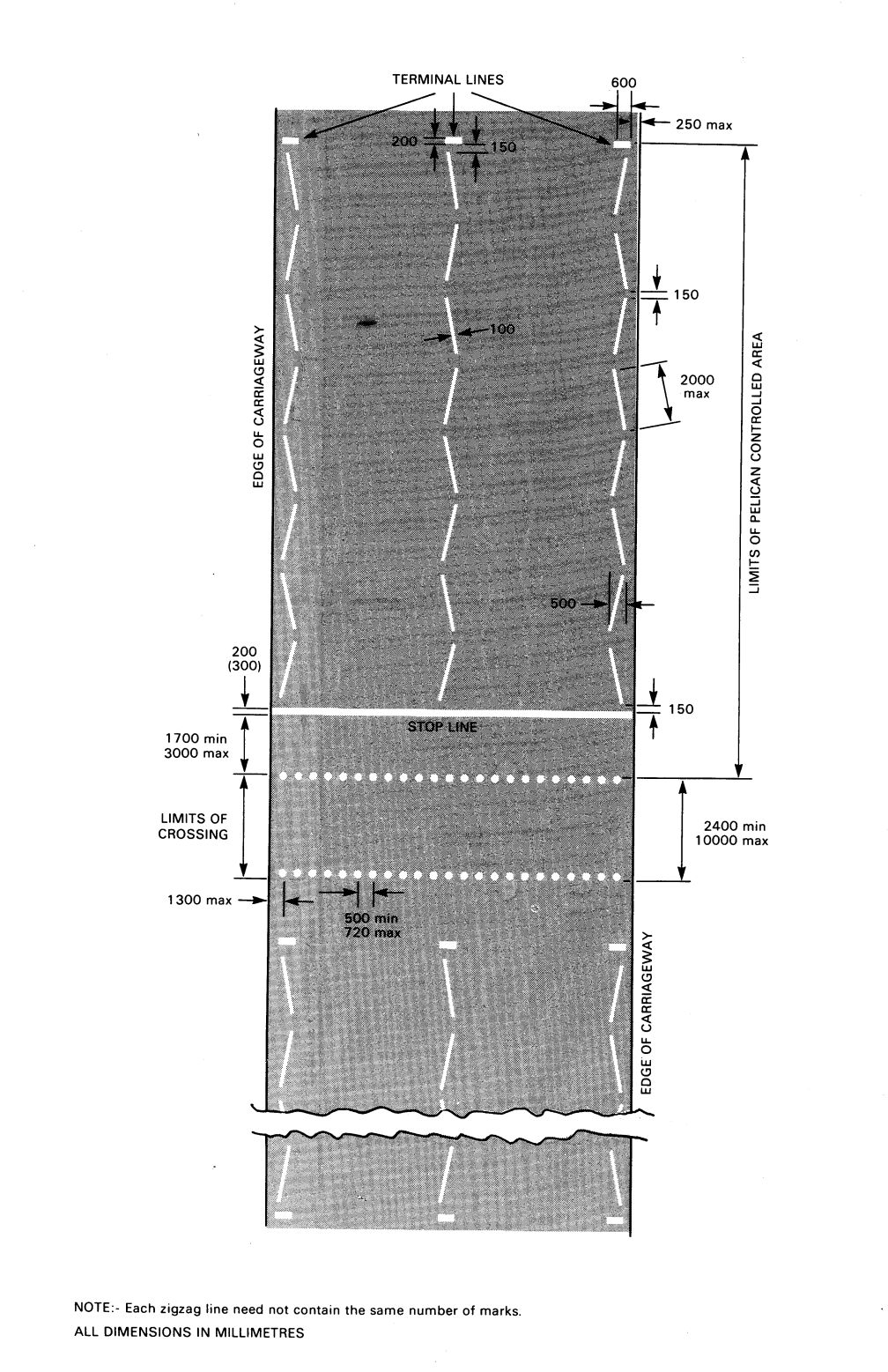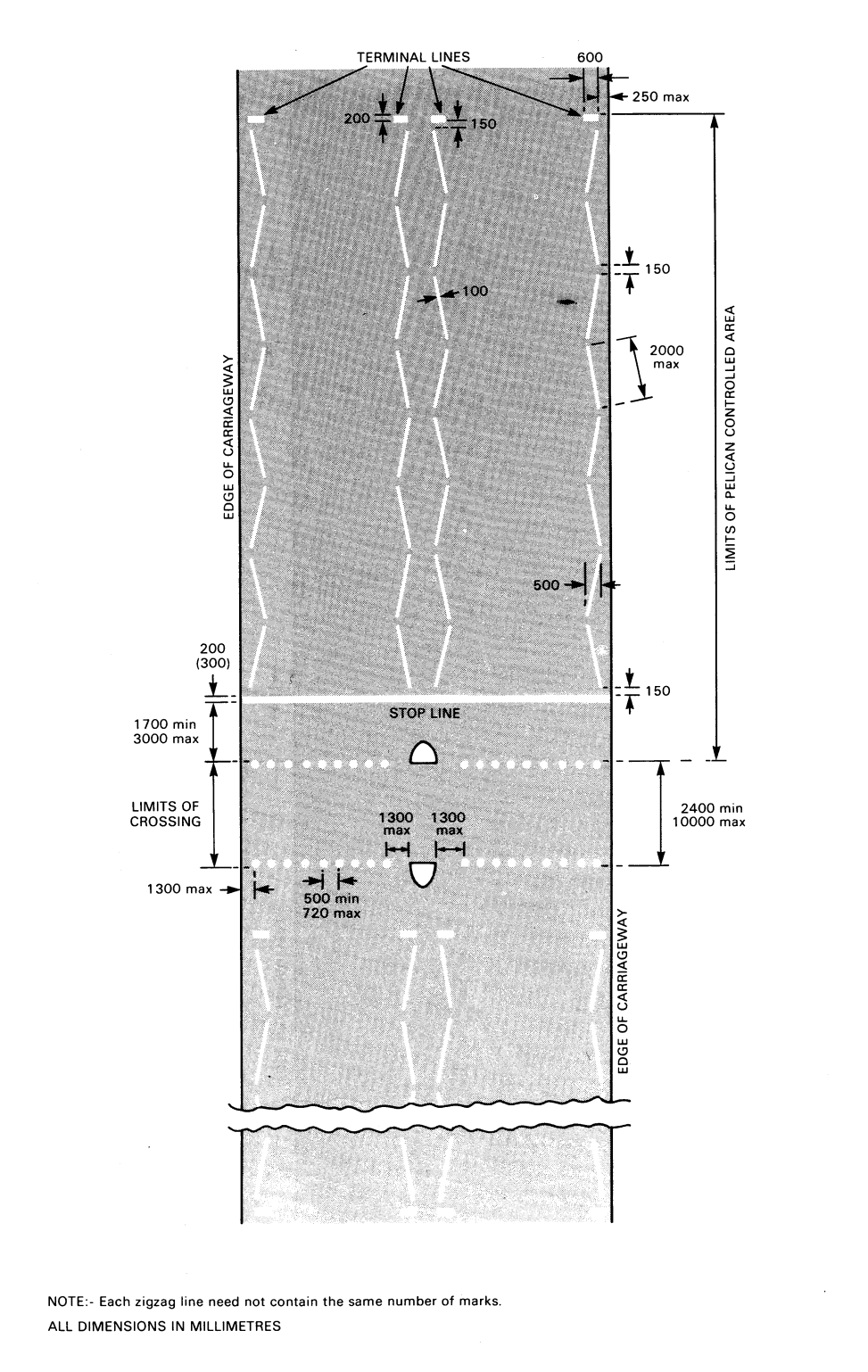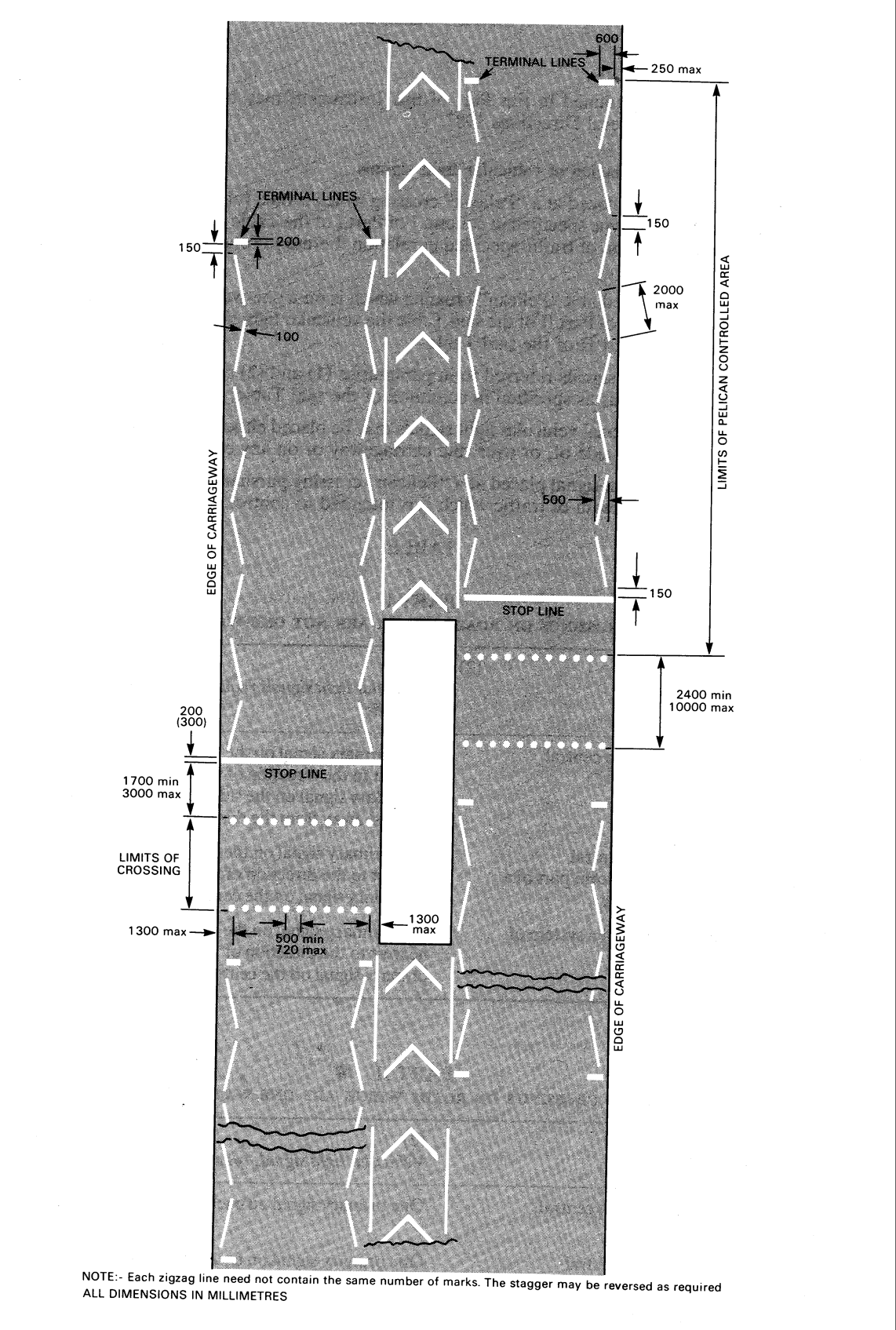- Latest available (Revised)
- Original (As made)
The Pelican Pedestrian Crossings Regulations and General Directions 1987
You are here:
- UK Statutory Instruments
- 1987 No. 16
- SCHEDULE 2
More Resources
Status:
This is the original version (as it was originally made). This item of legislation is currently only available in its original format.
Regulation 2(2)
SCHEDULE 2THE MANNER OF INDICATING THE PRESENCE AND LIMITS OF A “PELICAN” CROSSING AND “PELICAN” CONTROLLED AREA
General
1. In this Schedule, and except where otherwise stated, any reference to a numbered diagram is a reference to the diagram bearing that number in this Schedule.
2.—(1) Every crossing which is a “Pelican” crossing on a road which is not a one-way street shall have its limits indicated, subject to the following provisions of this Schedule, by the pattern of studs on or in and lines on the carriageway in the manner shown–
(a)in diagram 1 where there is no central reservation;
(b)in diagram 2 where there is a central reservation, but the crossing does not form part of a system of staggered crossings; and
(c)in diagram 3 where the crossing forms part of a system of staggered crossings.
(2) Every crossing which is a “Pelican” crossing on a road which is a one-way street shall have its limits indicated, subject to the following provisions of this Schedule, by the pattern of studs on or in and lines on the carriageway in the manner shown–
(a)in diagram 4 where there is no central reservation;
(b)in diagram 5 where there is a central reservation but the crossing does not form part of a system of staggered crossings; and
(c)in diagram 6 where the crossing forms part of a system of staggered crossings.
Manner of indicating the limits of the crossing
3. The limits of a “Pelican” crossing shall be indicated by two lines of studs in the positions shown, and in accordance with the measurements in, the diagram corresponding to the type of crossing.
4. The two lines of studs indicating the limits of the crossing need not be at right angles to the edge of the carriageway, but shall form straight lines and shall as near as is reasonably practicable be parallel to each other.
Manner of indicating a “Pelican” controlled area and provision as to placing the stop line
5. Subject to paragraph 8 of this Schedule, the presence and limits of a “Pelican” controlled area shall be indicated by the pattern of lines placed in the positions shown, and in accordance with the measurements, in the diagram corresponding to the type of crossing, and in accordance with the provisions of paragraphs 6 and 7 of this Schedule.
6. Where the crossing is on a road which is not a one-way street the pattern of lines shall consist of–
(1) a stop line placed on the carriageway parallel to the nearer row of studs indicating the limits of the crossing and extending, in the manner indicated in the appropriate diagram, across the part of the carriageway used by vehicles approaching the crossing from the side on which the stop line is placed;
(2) two or more longitudinal white broken lines (hereinafter referred to as “zig-zag lines”) placed on the carriageway or, where the road is a dual-carriageway road, on each part of the carriageway, each zig-zag line containing not less than 8 nor more than 18 marks and extending away from the crossing in the manner indicated in the appropriate diagram;
(3) subject to sub-paragraph (4) of this paragraph, where a central reservation is provided the road marking shown in diagram 1040.1 in Schedule 2 to the Traffic Signs Regulations 1981(1) may be placed on the carriageway between the zig-zag lines on the approaches to the central reservation;
(4) where a central reservation is provided connecting crossings which form part of a system of staggered crossings, the road markings mentioned in sub-paragraph (3) of this paragraph shall be placed on the carriageway in the manner indicated in diagram 3.
7. Where the crossing is on a road which is a one-way street the pattern of lines shall consist of:
(1) a stop line placed parallel to the nearer row of studs indicating the limits of the crossing and extending–
(a)in the case of a crossing of the type shown in diagram 4 or 5, from one edge of the carriageway to the other; and
(b)in the case of a crossing of the type shown in diagram 6, from the edge of the carriageway to the central reservation;
(2) two or more zig-zag lines placed on the carriageway, each containing not less than 8 and not more than 18 marks, and extending away from the crossing;
(3) subject to sub-paragraph (4) of this paragraph, where a central reservation is provided the road marking shown in diagram 1041 in Schedule 2 to the Traffic Signs Regulations 1981 may be placed on the carriageway between the zig-zag lines on the approaches to the central reservation; and
(4) where a central reservation is provided connecting crossings which form part of a system of staggered crossings, the road markings mentioned in sub-paragraph (3) of this paragraph shall be placed on the carriageway in the manner indicated in diagram 6.
8.—(1) Where the appropriate authority is satisfied in relation to a particular area of carriageway in the vicinity of a “Pelican” crossing that by reason of the layout of, or character of, the roads in the vicinity of the crossing it would be impracticable to lay the pattern of lines as shown in the diagrams in, and in accordance with paragraphs 5 to 7 of, this Schedule any of the following variations as respects the pattern shall be permitted–
(a)the number of marks contained in each zig-zag line may be reduced from 8 to not less than 2; and
(b)a mark contained in a zig-zag line may be varied in length so as to extend for a distance not less than 1 metre and less than 2 metres, but where such a variation is made as respects a mark each other mark in each zig-zag line shall be of the same or substantially the same length as that mark, so however that the number of marks in each zig-zag line shall not be more than 8 nor less than 2.
(2) The angle of the stop line in relation to the nearer line of studs indicating the limits of a crossing may be varied, if the appropriate authority is satisfied that such variation is necessary having regard to the angle of the crossing in relation to the edge of the carriageway at the place where the crossing is situated.
(3) The maximum distance of 3 metres between the stop line and the nearer line of studs indicating the limits of the crossing shown in the diagrams in this Schedule may be increased to such greater distance, not in any case exceeding 10 metres, as the appropriate authority may decide.
(4) Where by reason of regulation 3(3) an area of carriageway in the vicinity of a “Pelican” crossing is not constituted a “Pelican” controlled area by the placing of a pattern of lines as provided in the foregoing provisions of this Schedule, a stop line shall nevertheless be placed on the carriageway as previously provided in this Schedule.
Colour and dimensions of road markings and studs
9. The road markings shown in the diagrams in this Schedule shall be white in colour, and may be illuminated by reflecting material.
10.—(1) The studs shown in the diagrams shall be either white, silver or light grey in colour and shall not be fitted with reflective lenses.
(2) The said studs shall be either circular in shape with a diameter of not more than 110 millimetres or less than 95 millimetres or square in shape with each side being not more than 110 millimetres or less than 95 millimetres.
(3) Any stud which is fixed or embedded in the carriageway shall not project more than 18 millimetres above the carriageway at its highest point nor more than 6 millimetres at its edges.
11. Where in any diagram in this Schedule a dimension or measurement is indicated in brackets against a dimension or measurement not indicated in brackets any dimension or measurement indicated in brackets may be treated as an alternative to the dimension or measurement not so indicated.
Supplementary
12. The foregoing provisions of this Schedule shall be regarded as having been complied with in the case of any pattern of studs or white lines if most of the studs or lengths of white lines comply notwithstanding that one or more studs or some of the lengths of white lines may not comply with those provisions by reason of discoloration, temporary removal, displacement or for some other reason so long as the general appearance of the pattern of studs or white lines is not thereby materially impaired.
PART IIIgeneral directions
Citation
1. The Directions contained in this Part of this Instrument may be cited as the “Pelican” Pedestrian Crossings General Directions 1987.
Number and manner of placing of vehicular light signals
2.—(1) There shall be placed at a “Pelican” crossing which is on a road which is not a one-way street and which is of the type specified in column 1 of Part I of the Table below, the vehicular light signals facing each direction of traffic specified in relation thereto in column 2 of Part I of the said Table.
(2) There shall be placed at a “Pelican” crossing which is on a one-way street and which is of a type specified in column 1 of Part II of the said Table the vehicular light signals specified in relation thereto in column 2 of Part II of the said Table.
(3) The vehicular light signals referred to in paragraphs (1) and (2) shall be placed as primary signals or secondary signals as specified in column 2 of the said Table.
(4) One or more additional vehicular light signals may be placed either as a primary signal or as a secondary signal on the side of, or over, the carriageway or on any central reservation.
(5) Every vehicular light signal placed at a “Pelican” crossing pursuant to the provisions of this direction shall face the stream of traffic which it is intended to control.
TABLE
PART I
pelican crossings on roads which are not one-way streets
| (1) | (2) |
|---|---|
| Type of crossing | Vehicular light signals required facing each direction of traffic |
| Crossing on a road without a central reservation. | One primary signal on the side of the carriageway nearest to the direction of vehicular traffic and one secondary signal on the side of the carriageway furthest away from the direction of vehicular traffic. |
| Crossing on a road with a central reservation which does not form part of a system of staggered crossings. | One primary signal on the side of the carriageway nearest to the direction of vehicular traffic and one secondary signal on the central reservation. |
| Crossing which forms part of a system of staggered crossings. | One primary signal on the side of the carriageway nearest to the direction of vehicular traffic and one primary signal on the central reservation. |
PART II
pelican crossings on roads which are not one-way streets
| (1) | (2) |
|---|---|
| Type of crossing | Vehicular light signals required |
| Crossing on a road without a central reservation. | One primary signal on each side of the carriageway. |
| Crossing on a road with a central reservation which does not form part of a system of staggered crossings. | One primary signal on each side of the carriageway and one secondary signal on the central reservation. |
| Crossing which forms part of a system of staggered crossings. | One primary signal on the side of the carriageway and one primary signal on the central reservation. |
Number and manner of placing of pedestrian light signals and indicators for pedestrians
3.—(1) At least one pedestrian light signal and at least one indicator for pedestrians shall be placed at each end of a “Pelican” crossing.
(2) Where there is a central reservation in a crossing, one or more additional indicators for pedestrians shall be placed on the central reservation.
(3) Each pedestrian light signal at either end of the crossing shall be so placed as to be clearly visible to any person who is about to use the crossing at the other end of the crossing.
(4) Each indicator for pedestrians shall be so placed that the push button in the indicator is readily accessible to pedestrians who wish to press it.
Additional traffic signs
4. The traffic signs specified in diagrams 610 and 611 in Schedule 1 to the Traffic Signs Regulations 1981 shall be placed only on a central reservation in a crossing, or on a central reservation which lies between two crossings which form part of a system of staggered crossings.
Colouring of containers and posts
5.—(1) The containers of the vehicular light signals and of the pedestrian light signals shall be coloured black and may be mounted with a backing board and if so mounted the backing board shall be coloured black and may have a white border not less than 45 millimetres nor more than 55 millimetres in width which may be of a reflective material.
(2) Where a vehicular light signal, a pedestrian light signal or an indicator for pedestrians is mounted on a post specially provided for the purpose, that part of the post which extends above ground level shall be coloured grey and may have one white band not less than 140 millimetres nor more than 160 millimetres in depth, the lower edge of the band being not less than 1.5 metres nor more than 1.7 metres above the level of the surface of the ground in the immediate vicinity.
(3) Any box attached to a post or other structure on which pedestrian light signals or vehicular light signals are mounted and housing apparatus designed to control, or to monitor, or to control and monitor, the operation of such signals shall be coloured grey, yellow or black, or a combination of any of those colours.
Approval for mechanisms and sequence adjustments
6.—(1) Vehicular light signals, pedestrian light signals and indicators for pedestrians may be placed at or near any “Pelican” crossing only if the apparatus (including the content of all instructions stored in, or executable by, it) used to secure that the signals and indicators comply with the relevant provisions of the Regulations is of a type approved in writing by or on behalf of the Secretary of State.
(2) Such signals may be retained in place notwithstanding the subsequent withdrawal of any approval relating to any such apparatus.
Special Cases
7. Nothing in these Directions shall be taken to limit the power of the Secretary of State by any special direction to dispense with, add to or modify any of the requirements of the Directions in relation to any particular case.
S.I. 1981/859, to which there are no relevant amending instruments.
Options/Help
Print Options
PrintThe Whole Instrument
PrintThis Schedule only
Legislation is available in different versions:
Latest Available (revised):The latest available updated version of the legislation incorporating changes made by subsequent legislation and applied by our editorial team. Changes we have not yet applied to the text, can be found in the ‘Changes to Legislation’ area.
Original (As Enacted or Made): The original version of the legislation as it stood when it was enacted or made. No changes have been applied to the text.
More Resources
Access essential accompanying documents and information for this legislation item from this tab. Dependent on the legislation item being viewed this may include:
- the original print PDF of the as enacted version that was used for the print copy
- lists of changes made by and/or affecting this legislation item
- confers power and blanket amendment details
- all formats of all associated documents
- correction slips
- links to related legislation and further information resources
More Resources
Use this menu to access essential accompanying documents and information for this legislation item. Dependent on the legislation item being viewed this may include:
- the original print PDF of the as made version that was used for the print copy
- correction slips
Click 'View More' or select 'More Resources' tab for additional information including:
- lists of changes made by and/or affecting this legislation item
- confers power and blanket amendment details
- all formats of all associated documents
- links to related legislation and further information resources
